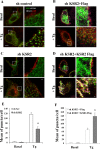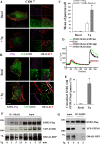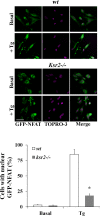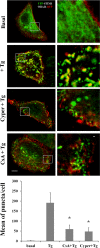The KSR2-calcineurin complex regulates STIM1-ORAI1 dynamics and store-operated calcium entry (SOCE)
- PMID: 24672054
- PMCID: PMC4038503
- DOI: 10.1091/mbc.E13-05-0292
The KSR2-calcineurin complex regulates STIM1-ORAI1 dynamics and store-operated calcium entry (SOCE)
Abstract
Store-operated calcium entry (SOCE) is the predominant Ca(2+) entry mechanism in nonexcitable cells and controls a variety of physiological and pathological processes. Although significant progress has been made in identifying the components required for SOCE, the molecular mechanisms underlying it are elusive. The present study provides evidence for a direct involvement of kinase suppressor of Ras 2 (KSR2) in SOCE. Using lymphocytes and fibroblasts from ksr2(-/-) mice and shKSR2-depleted cells, we find that KSR2 is critical for the elevation of cytosolic Ca(2+) concentration. Specifically, our results show that although it is dispensable for Ca(2+)-store depletion, KSR2 is required for optimal calcium entry. We observe that KSR2 deficiency affects stromal interaction molecule 1 (STIM1)/ORAI1 puncta formation, which is correlated with cytoskeleton disorganization. Of interest, we find that KSR2-associated calcineurin is crucial for SOCE. Blocking calcineurin activity impairs STIM1/ORAI1 puncta-like formation and cytoskeleton organization. In addition, we observe that calcineurin activity and its role in SOCE are both KSR2 dependent.
© 2014 Giurisato et al. This article is distributed by The American Society for Cell Biology under license from the author(s). Two months after publication it is available to the public under an Attribution–Noncommercial–Share Alike 3.0 Unported Creative Commons License (http://creativecommons.org/licenses/by-nc-sa/3.0).
Figures








Similar articles
-
cAMP induces stromal interaction molecule 1 (STIM1) puncta but neither Orai1 protein clustering nor store-operated Ca2+ entry (SOCE) in islet cells.J Biol Chem. 2012 Mar 23;287(13):9862-9872. doi: 10.1074/jbc.M111.292854. Epub 2012 Feb 1. J Biol Chem. 2012. PMID: 22298778 Free PMC article.
-
Thapsigargin activates Ca²+ entry both by store-dependent, STIM1/Orai1-mediated, and store-independent, TRPC3/PLC/PKC-mediated pathways in human endothelial cells.Cell Calcium. 2011 Feb;49(2):115-27. doi: 10.1016/j.ceca.2010.12.001. Epub 2010 Dec 28. Cell Calcium. 2011. PMID: 21193229
-
Lysophosphatidic acid promotes cell migration through STIM1- and Orai1-mediated Ca2+(i) mobilization and NFAT2 activation.J Invest Dermatol. 2013 Mar;133(3):793-802. doi: 10.1038/jid.2012.370. Epub 2012 Oct 25. J Invest Dermatol. 2013. PMID: 23096711 Free PMC article.
-
Key components of store-operated Ca2+ entry in non-excitable cells.J Pharmacol Sci. 2014;125(4):340-6. doi: 10.1254/jphs.14r06cp. Epub 2014 Jul 17. J Pharmacol Sci. 2014. PMID: 25030742 Review.
-
Regulation of Orai1/STIM1 by the kinases SGK1 and AMPK.Cell Calcium. 2012 Nov;52(5):347-54. doi: 10.1016/j.ceca.2012.05.005. Epub 2012 Jun 7. Cell Calcium. 2012. PMID: 22682960 Review.
Cited by
-
Ultrastructural study of spermatogenesis in KSR2 deficient mice.Transgenic Res. 2015 Aug;24(4):741-51. doi: 10.1007/s11248-015-9886-4. Epub 2015 Jun 9. Transgenic Res. 2015. PMID: 26055731
-
Cell non-autonomous regulation of hepatic IGF-1 and neonatal growth by Kinase Suppressor of Ras 2 (KSR2).Sci Rep. 2016 Aug 26;6:32093. doi: 10.1038/srep32093. Sci Rep. 2016. PMID: 27561547 Free PMC article.
-
Loss of Two-Pore Channel 2 (TPC2) Expression Increases the Metastatic Traits of Melanoma Cells by a Mechanism Involving the Hippo Signalling Pathway and Store-Operated Calcium Entry.Cancers (Basel). 2020 Aug 24;12(9):2391. doi: 10.3390/cancers12092391. Cancers (Basel). 2020. PMID: 32846966 Free PMC article.
-
Notoginsenoside R1 Alleviates Oxygen-Glucose Deprivation/Reoxygenation Injury by Suppressing Endoplasmic Reticulum Calcium Release via PLC.Sci Rep. 2017 Nov 24;7(1):16226. doi: 10.1038/s41598-017-16373-7. Sci Rep. 2017. PMID: 29176553 Free PMC article.
-
Dysregulation of Neuronal Calcium Signaling via Store-Operated Channels in Huntington's Disease.Front Cell Dev Biol. 2020 Dec 23;8:611735. doi: 10.3389/fcell.2020.611735. eCollection 2020. Front Cell Dev Biol. 2020. PMID: 33425919 Free PMC article. Review.
References
-
- Cacace AM, Michaud NR, Therrien M, Mathes K, Copeland T, Rubin GM, Morrison DK. Identification of constitutive and ras-inducible phosphorylation sites of KSR: implications for 14-3-3 binding, mitogen-activated protein kinase binding, and KSR overexpression. Mol Cell Biol. 1999;19:229–240. - PMC - PubMed
-
- Cantini M, Giurisato E, Radu C, Tiozzo S, Pampinella F, Senigaglia D, Zaniolo G, Mazzoleni F, Vitiello L. Macrophage-secreted myogenic factors: a promising tool for greatly enhancing the proliferative capacity of myoblasts in vitro and in vivo. Neurol Sci. 2002;23:189–194. - PubMed
-
- Carafoli E. The calcium-signalling saga: tap water and protein crystals. Nat Rev Mol Cell Biol. 2003;4:326–332. - PubMed
-
- Dolmetsch RE, Keli X, Lewis RS. Calcium oscillations increase the efficiency and specificity of gene expression. Nature. 1998;392:933–936. - PubMed
Publication types
MeSH terms
Substances
LinkOut - more resources
Full Text Sources
Other Literature Sources
Molecular Biology Databases
Miscellaneous

